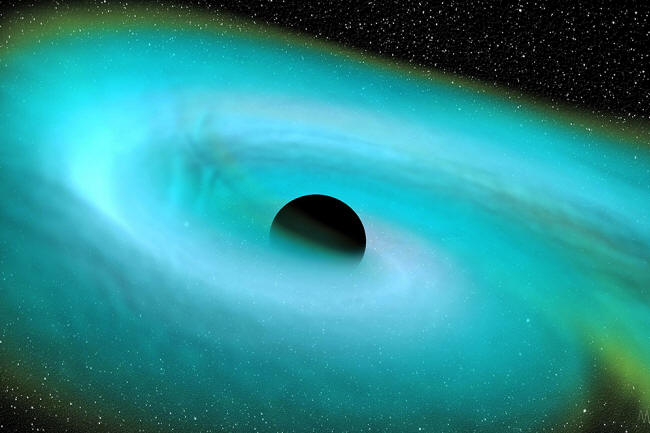|

by Katyanna Quach
June 30,
2021
from
TheRegister Website

Image from a MAYA collaboration numerical
relativity simulation of an NSBH binary merger,
showing the disruption of the Neutron Star.
Credit: Deborah Ferguson (UT Austin),
Bhavesh Khamesra (Georgia Tech),
and Karan Jani (Vanderbilt)
You wait ages
for a neutron
star
and black hole
to collide,
then two pairs
come along
at once...
Gravitational wave detectors have reportedly spotted the merger of a
black hole and a
neutron star - not once but twice in the same month.
This is the first time
scientists have been able to confirm the detection of the merger of
a black hole and neutron star, too.
Although several
gravitational wave events have been detected since America's
Laser Interferometer Gravitational-Wave Observatory (LIGO) made
the first
gravity wave discovery in 2015,
they have always involved collisions between objects of the same
type, such as two black holes smashing into each other, or two
neutron stars.
These latest discoveries, however, are the result of odd pairings: a
black hole with nine times the mass of our Sun crashing into a
1.9-solar-mass neutron star, and a slightly smaller black hole
measuring six solar masses impacting with a 1.5-solar-mass neutron
star.
The cosmic prangs were announced on Tuesday by multiple teams
working with the
LIGO and
Virgo detectors in Louisiana, USA,
and Santo Stefano a Macerata, Italy, respectively.
As the LIGO and Virgo detectors become more and more finely tuned,
the detection of these merger events are expected to crop up like
buses:
none for ages, and
then many along at once.
These latest collisions
were detected ten days apart, on January 5, 2020, at 1624 UTC, and
January 15 at 0423 UTC.
The first event, the more energetic of the two and
involving the more massive bodies, was code-named
GW200105, and took place about 900
million light-years from Earth.
The second event,
referred to as
GW200115, was further away at about
one billion light-years away.
"We had long expected
to see a merger between a black hole and neutron star, but there
are many uncertainties that made it difficult to predict how
many of this pairing there are in our universe," Ryan Magee,
co-author of a paper (Observation
of Gravitational Waves from Two Neutron Star-Black Hole
Coalescences) published in The Astrophysical
Journal and a postdoctoral scholar at the California
Institute of Technology, told The Register.
"From these two detections, we can infer that, in a fixed volume
of space, there are a few more neutron star-black hole mergers
per year than black hole-black hole [ones], but not as many as
there are neutron star-neutron star mergers."
Previous attempts to
confirm a black hole-neutron star collision were unfruitful.
One signal detected in
April 2019 may have been skewed by noise, and another from August of
the same year is
still being debated.
Both black holes likely swallowed their neutron stars whole, leaving
no trace of light for the team to follow.
"These were not
events where the black holes munched on the neutron stars like
the cookie monster and flung bits and pieces about," Patrick
Brady, a professor at University of Wisconsin-Milwaukee and
spokesperson of the LIGO Scientific Collaboration,
said in a statement.
"That 'flinging
about' is what would produce light, and we don't think that
happened in these cases."
A merger between a
galactic void and the densest type of star probably occurs within a
billion light years of Earth about once a month, the team reckon.
"The detector groups
at LIGO, Virgo, and
KAGRA are improving their
detectors in preparation for the next observing run scheduled to
begin in summer 2022," Prof Brady added.
"With the improved
sensitivity, we hope to detect merger waves up to once per day
and to better measure the properties of black holes and
super-dense matter that makes up neutron stars."
|


